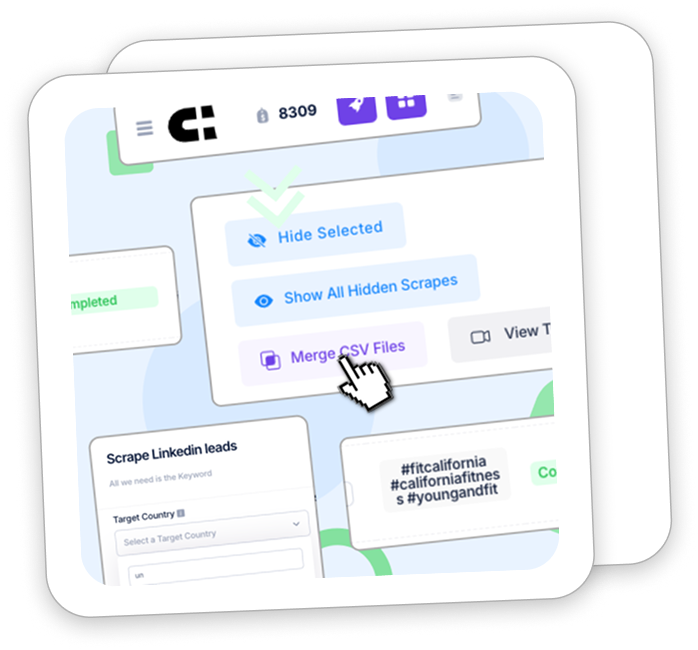Social Media Scraper
Benefits
Scrape Facebook Groups
Just enter the Facebook Group name and it will scrape all public profiles inside group with emails and phone numbers.
Scrape #Hashtags
Get information from #Hashtags on Instagram, Twitter & Linkedin and gain emails and phone numbers.
Scrape Keywords
Get Keywords on Instagram, Twitter & Linkedin and gain emails and phone numbers.
Build A Email List Quickly
You don’t have to spend all your money on Facebook ads and google ads to get the leads you want.
Trusted by 50,000 + marketers at companies including…
.png)
See What Customers Are Saying About Our Software
Platform is easy to use, training videos are short and to the point. Support is very helpful. turn around time for most of my scrapes was 24 hours. Very useful for any business to get new leads.

Julia Keys
Consultant
5/5
In a word, IGleads.io provide the best service. If you are a digital marketing agency owner, you should try their service. Also, their customer support is amazing. Hope you will get the best experience.

Julia Keys
CEO & Founder
5/5
IGleads.io… is highly affordable and super easy to use platform and I am so glad I found IGleads.io
Their support in lightning-fast and it only takes a minute or so to get their chat support!

Mark Smith
5/5
I am on Ig leads since 2 Weeks and already have my first sales. Very good customer servive which helps you with all that you need to know. Love this platform.

Jonathan Gate
Product Director
5/5
Great product and great customer service!
Has allowed me to scrape contact information effortlessly and build an email list to support my businesses marketing efforts!

Sergio Jota
Lead Manager
5/5
IGLeads.io is a KILLER solution!!! No more messing around with proxies, IG blocks and verifications. This is soooo much easier and worth every PENNY!!! This tool is producing results that are better than the good ole Jarvee days

Julia Keys
Founder & Owner
5/5
Trustpilot
How Will IGLeads.io Unlock Your Business Potential?

Run Advertising Campaigns
Once you’ve scrape emails from any platform, upload them to Google Ads or Facebook for running campaigns.

Email Marketing
It’s time to send out those cold emails. Prove that you’re on their minds with a great offer and close more deals!

Content Marketing
If you have the emails from your list, now is a great time to start creating blog posts that offer them some type of value.

Product Research
Promote the products you’re interested in and see which ones receive feedback or clicks so that you know what your potential buyers want!
IGLeads was able to learn from the world’s best marketers and email Marketing experts about how to scrape #hashtags, Facebook groups, or keywords. By using AI, you can rest easy knowing your data is safe. You don’t have to worry about proxies or accounts getting banned because it will stay 100% compliment with terms and conditions
Get All The Data You Need
From All The Platforms

Youtube





TikTok
STARTER PLAN
$49/mo
10k Emails Monthly
Original Price $79/mo
- Verified Emails
- Instagram Scraping
- Facebook Scraping
- LinkedIn Scraping
- Tik Tok Scraping
- Twitter Scraping
- Youtube Scraping
- Website Scraping
- Google Scraping
- 100% Automated
- Cancel Anytime
Training Videos Included
- Scraping Course
- Cold Email Course
- Google Ads Course
- Facebook Ads Course
- Google SEO Course
BUSINESS PLAN
Most Popular
$119/mo
Unlimited Emails Monthly
Original Price $299/mo
- ✅ Verified Emails
- ✅ Instagram Scraping
- ✅ Facebook Scraping
- ✅ LinkedIn Scraping
- ✅ TikTok Scraping
- ✅ Twitter Scraping
- ✅ Youtube Scraping
- ✅ Website Scraping
- ✅ Google Scraping
- ✅ 100% Automated
- ✅ Cancel Anytime
Training Videos Included
- ✅ Scraping Course
- ✅ Cold Email Course
- ✅ Google Ads Course
- ✅ Facebook Ads Course
- ✅ Google SEO Course
V.I.P MEMBER PLAN
$650/yearly
Unlimited Emails Yearly
Original Price $1,800/yearly
Our Policy
“Over the next 7 days, make an informed decision if IGLeads.io meets the hype. If you’re not satisfied with the joy from the emails IGLeads scraped for you, then simply email support@igleads.io and we’ll instantly refund 100% of your money. You can not request if you got over 1,000 emails.
FAQ
Yes many of our members use our software to sell to their own clients.
How Quickly Can IGLeads Scrape Emails
Our services work at the highest possible speed to get you your results. There are factors that slow down scraping, such as the current server load, and the amount of users you’re scraping. On average you can expect results in under 8 hours for any scrape.
Why Scrape Emails From Social Media Platforms?
Everyone has an Instagram, Twitter, Facebook, and tik tok these days, and thus, an email address tied to their accounts. This means you can leverage this to get in touch with anyone you want. Whether you’re looking to find high ticket clients in your niche, increase your ROAS by creating lookalikes, cold email prospects with your offer, or even snipe a competitor’s followers – there are so many reasons to scrape emails from.
What to do if my leads is taking a long time?
The average search takes 1 – 48 hours to complete, and we do our best to make sure your scrape finishes in under 12 hours.
Do I need to know how to code?
Not at all! All you need to do is put in the keywords or hashtags the account you want to scrape. That’s it!
Do I need to have my computer on while I scrape?
Definitely not. Our cloud-based software scrapes even when you close down and turn off your computer.
We have a 100% refund policy if the service does not work. It also takes up to 30 days to process a refund if approved.
You no longer can get a refund if you get over 1,000 emails captured.
What is your cancellation policy?
You can easily cancel your subscription anytime from the dashboard on the website. You are responsible for canceling the subscription.
Accounts will also be locked out no matter what date you purchased until you make your subscription active again.
What is the max I can scrape per search?
Scrape keywords: 20k Emails Daily
Scrape Hashtags: 20k Emails Daily.
Do I need to login with my Instagram account?
No login is needed! You just log in to your account on our website, and that’s all you need to get started!
What data can I get in my scrape?
We scrape username, bio, name, website link, email, and phone number. This is all public data from google.
What do I need to know when selecting a keyword to scrape?
Make sure you have high traffic keywords and hashtags.
We don’t support scraping IGTV, reels, or any private profiles.
How can I get in contact with you?
Reach out to us at support@igleads.io with any additional questions
DMCA & CFAA Compliant
- There’re no precedents of Google suing businesses over scraping its results pages.
- Scraping of Google SERPs isn’t a violation of DMCA or CFAA.
- Given that results on Google SERPs are not protected by copyright, it’s only logical that IGLeads.io doesn’t violate DMCA by scraping them.
- Since information on Google SERPs is also publicly available and non-password protected, IGLeads.io doesn’t break CFAA by scraping it.
IGlead.io is fully committed to complying with all relevant data protection legal requirements, including DMCA or CFAA. We do not log into any platform to access data or use IP’s or multiple accounts to try and scrape unauthorized data. We scrape 100% through google SERPs.


Meet IGotLeads – Your AI Scraping Tool.
Rated 4.6/5 Stars – Excellent Customer Satisfaction
How Are We Complying With Facebook Terms & Conditions
** IGotLeads is not affiliated, associated, authorized, endorsed by, or in any way officially connected with Meta (Facebook) or any social media platform, any of its subsidiaries, or its affiliates **
social media scraping
igleads.io lead scraper
igleads.io scrape website keywords
igleads.io fb group scraper
site:igleads.io
social scraper
igleads.io scraping linkedin
social media scrape scraper
google ads scraper
scrape social media
igleads.io linkedin web scraper
scraping social media
social media app scraping
social email scraper
social media scrapers
igleads.io youtube scraper
scrape social media data
igleads.io facebook scraper
social scrape
igleads.io/google-scraper
what is social media scraping
social media lead extraction
igleads.io price
scraping social media data
igleads.io web scraper
social media scraping tool
social media scrapper
igleads.io/vp
facebook ads scraper
igleads.io lead scrape
best social media scraping tools
extract data from facebook group
social extractor
social media data extraction
social media extractor
extract instagram emails
how to extract data from social media
hype scrape
igleads pricing
igleads.io simple scraper
social media scraping tools
Any Questions
No, logging into the platform to access data would be a violation of these terms and conditions. Our company does not log into the platform to access data. All of our data is through google public search which does not violate any terms and conditions. We have never accessed Facebook data in an unauthorized way and we never will. We take compliance with Facebook terms and conditions very seriously. We give you an even better option which is scraping #hashtags. Read more here
Many popular platforms that offer Facebook scraping features are constantly breaking the rules and getting shut down. Our platform is different. We use a unique method that doesn’t violate any of Facebook’s terms and conditions. This means that our platform is always available, and you can scrape Instagram #Hashtags Instagram Keywords Facebook Groups Facebook Keywords So if you’re looking for a reliable way to gather public data from Facebook without getting banned, our platform is the perfect solution.
Yes, many of our members use our software to sell to their own clients.
Our services work at the highest possible speed to get you your results. There are factors that slow down scraping, such as the current server load, and the number of users you’re scraping. On average, you can expect results in under 8 hours for any scrape.
Everyone has an Instagram, Twitter, Facebook, and tik tok these days, and thus, an email address tied to their accounts. This means you can leverage this to get in touch with anyone you want. Whether you’re looking to find high ticket clients in your niche, increase your ROAS by creating lookalikes, cold email prospects with your offer, or even snipe a competitor’s followers – there are so many reasons to scrape emails from.
The average search takes 1 – 48 hours to complete, and we do our best to make sure your scrape finishes in under 12 hours.
Not at all! All you need to do is put in the keywords or hashtags the account you want to scrape. That’s it!
Definitely not. Our cloud-based software scrapes even when you close down and turn off your computer.
We have a 100% refund policy if the service does not work. It also takes up to 30 days to process a refund if approved. You no longer can get a refund if you get over 1,000 emails captured.
You can easily cancel your subscription anytime from the dashboard on the website. You are responsible for canceling the subscription. Accounts will also be locked out no matter what date you purchased until you make your subscription active again.
Scrape keywords: 20k Emails Daily Scrape Hashtags: 20k Emails Daily.
No login is needed! You just log in to your account on our website, and that’s all you need to get started!
We scrape username, bio, name, website link, email, and phone number. This is all public data from google.
Make sure you have high traffic keywords and hashtags.
We don’t support scraping IGTV, reels, or any private profiles.
Reach out to us at support@igleads.io with any additional questions












